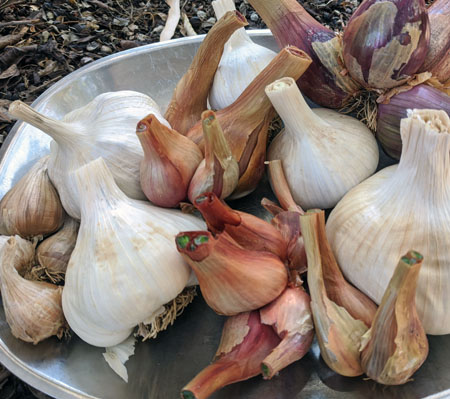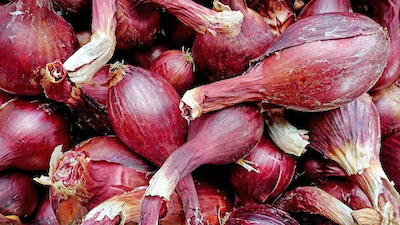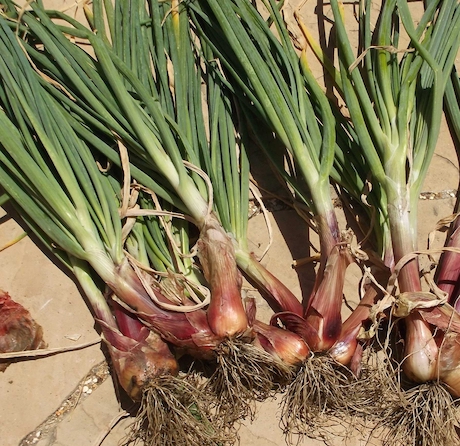Shallot: Allium Elan
By Margaret Klein Wilson, Fairfax Master Gardener Intern
My investigation into shallots included reading extension service publications and seed catalogs, weeding my way through garden and food blogs and finally, checking out the Allium section of the produce aisle in local markets.
Until 2010, the shallot was classified as a separate species, Allium ascalonicum, a name that is a synonym of Allium cepa, its current name. Type “shallots” into an extension website, and it appears with onions and garlic, a kind of Allium middle child, bridging the similarities of onions and garlic.

Shallots and garlic
A shallot is garlic’s near twin in cultivating practices and its favored partner in recipes ad infinitum. Considered on its own merits, a shallot is sublimely itself: often slender, with near white flesh, sheathed in a reddish, coppery skin and known to inspire culinary poetry.
“All shallots are rather fickle and they do need pampering to come to full perfection,” says William Woys Weaver, food ethnographer. The variables in pH needs and other factors may prove his opinion to be true; however, there are enough similarities in the care, cultivation and harvesting of this Allium trio to make the differences feel more like nuances.
Onions, shallots and garlic all thrive in sunny locations in a moderate temperature range of 55 to 75 degrees F (12-24° C). A “light” soil that is loose and moist, without being wet, and of a sandy loam composition is ideal for all three. The addition of organic matter and compost before planting is advised. The optimum pH range is 5.0 to 7.0. Shallots prefer a slightly sweeter soil, with a pH of 5.0 to 6.8. Achieving that fine pH point may be some of the pampering to which Weaver alluded. VCE recommends fertilizing with 10-10-10 (3 pounds per 100 square feet) before planting and side dressing with 10-10-10 at a rate of 2 pounds per 100 square feet twice during the growing season.
Another aspect of tender care for shallots is how they are planted. Shallots can be grown from seeds indoors and set in the garden as soon the ground is friable. They can also be grown from bulb sections, similar to garlic cloves, and benefit from a cool spring start. Shallot bulbs have multiple sections. Each section is set into the ground, root end down, with the tip barely covered with soil. Plant bulbs 4 to 6 inches apart (10-15 cm) in rows spaced 12 to 18 inches apart (30-45 cm). This will allow the growth of larger bulb clusters and hence, more numerous sections. Mulching will keep the weeds down and protect the shallow rooting of the developing plants. Pampering shallots is not to plant the bulb too deeply. Doing so will minimize bulb bruising or rot. That and onion maggots or thrips are the main threats to a healthy crop.

Red shallots
Shallots and garlic are often planted in spring and fall. Shallots may be harvested and used as green onions when they are 6 to 8 inches tall or left to mature and be harvested after the tops wither and dry out. Once dried and cured for about a week, bulbs will store well in a cool, dry area. Some bulbs may be used for a fall planting, but be sure to hold some dry bulbs over to become sets for the next spring planting. Shallot sets can be pricey.
Shallot varieties available today in many markets include the French red style bulbs such as ‘Ambition.’ If you want to grow your own, you might try the hybrid ‘Echalion’ with a sugar profile well-suited for caramelizing. It features a more pronounced elongated shape, is easier to peel and process and has a slightly citrusy taste. Each has approximately 105 days maturation and has been developed for longer storage.

Harvested shallots
Shallots have long been a standard of Asian and Indian cooking, but they also have roots in European cuisine. Subtly spicier than onions, sweeter than garlic, shallots add sass and a bit of heat to sauces, salads and vinaigrette. They are splendid when pickled, fragrant and smoky when caramelized, and a delicate, savory garnish sliced thin and fried. They will upscale anything they are paired with, and, like its onion kin, will also make you cry.
A supply of shallots and garlic bulbs are a winter treasure to savor and experiment with, separately or together. There is still time to introduce a new crop in the fall or to pick up a few bulbs to inspire a menu.
British garden and travel writer, Patience Gray, inspires me to replicate this dish: “Some hours after eating this dish [Lièvre à la royale, which contains 20 cloves of garlic and twice that quantity of shallots], there is a peculiar sensation of liberation in the head, and it is sensation of smell.”
Resources
Onions, Garlic and Shallots, Virginia Cooperative Extension, Publication 426-411
Wireworms and Maggots — Vegetables, University of Maryland Extension
Onions and Related Crops, University of Massachusetts-Amherst
Cooking with Shallots, Tabitha Alterman, Mother Earth News
Shallots, Home Gardening, Cornell University
Onion, Wikipedia
100 Vegetables and Where They Come From, William Woys Weaver
Plats du Jour, Patience Gray